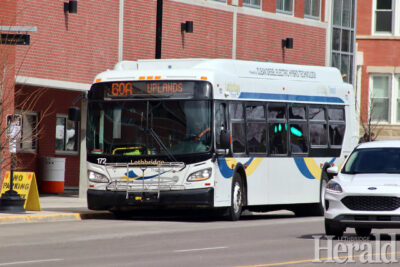Transit has long and storied history in Lethbridge
By Alejandra Pulido-Guzman - Lethbridge Herald on April 13, 2022.
 Herald photo by Alejandra Pulido-Guzman
Retired Lethbridge Transit employee Diane Boulton discusses the history of public transit in Lethbridge at the Galt Museum and Archives, during their Galt Presents series.
Herald photo by Alejandra Pulido-Guzman
Retired Lethbridge Transit employee Diane Boulton discusses the history of public transit in Lethbridge at the Galt Museum and Archives, during their Galt Presents series.LETHBRIDGE HERALDapulido@lethbridgeherald.com
The Galt Museum and Archives hosted retired LA Transit management team member Diane Boulton, to discuss the history of public transit in Lethbridge recently as part of their Galt Present series.
Boulton’s career with Lethbridge Transit started in 1978 as a school bus operator. She worked her way through the company until 2013, when she retired as part of the management team.
She started her presentation with a slideshow where images told the history of the city’s transit, starting with the railway streetcar from 1912 to the buses we see in the streets today.
Boulton said the City of Lethbridge developed the municipal street railway in 1912 originally to stall the separation of North Lethbridge from South Lethbridge.
She said in 1911 there was a boom going on in the province of Alberta and Edmonton, Calgary and Lethbridge were all relatively the same size.
“There were plans within the city of Lethbridge for it to get to a population of 25,000 but if North Lethbridge in fact broke away, those plans were going to fall away,” said Boulton.
She said the reason why they wanted to break away was because they could not get service for their residents, as the CP rail line ran through downtown.
She said it was at that time when the city fathers decided to order five cars and the construction of the lines from downtown to North Lethbridge and Henderson Lake as well as South Lethbridge.
“The five lines were called the red, blue, white, yellow and orange lines,” said Boulton.
She said the opening was done in conjunction with an early version of AgExpo and a pharmacist conference in 1912.
“In the first three days of the service in September 1912 they carried 64,000 people out to the exhibition grounds and back,” said Boulton.
She said that even though they carried that many people at the beginning, they struggled financially and at the end of the year they were in the red.
“In 1939 it was decided that the cars had to go, so the city started to look at purchasing buses and bought three buses that have been used somewhere else and already had 350,000 miles on them,” said Boulton.
She said the first lines to be replaced with buses were the white and red lines. The full conversion was stopped by the government of Canada because the Second World War had started and there was a shortage of gas. By 1947, the streetcar system had been abandoned, with the North Lethbridge line being the last to operate.
Boulton said the first buses only operated for a few years across the city because the streets were not paved yet and it was hard on the buses.
“In 1974 or thereabouts, the City of Lethbridge started servicing school buses using the trans coaches. Eventually in 1975 the city would start to purchase yellow school buses,” said Boulton.
She said they continued to deliver school bus service to both school boards until 2019.
Boulton said that as the years went by, the city went through different types of buses and by 1997 they moved on to low floor buses which had no steps at the front door and helped with accessibility and the department continued with that type of buses for many years.
She said in 2000 the University of Lethbridge and Lethbridge College became major destinations and became mini bus terminals. Before that, everyone had to go to downtown as the buses were running in a round trip style.
“Everyone had to come to the downtown terminal in order to transfer to get on a bus to carry on to the south side, to the west side, or wherever,” said Boulton.
She said after that they started looking at ways to reduce travelling times for bus users. But as the city expanded, the more areas they had to service the trips got longer. She said it was then when they started to introduce more buses per route.
“Every time we expanded, we added more cost to the department. We had to buy a vehicle, we had to find an operator for that vehicle,” said Boulton.
In 2003 the LINK route was introduced which connected the north and south sides and eliminated the need to go to downtown to transfer.
“One area we always struggled with was the west side,” said Boulton.
She said one of the ways they struggled was due to the way the new subdivisions were being developed as it was hard to navigate with the big buses as they could not get turned around easily.
In 2006 the north side terminal was introduced in order to accommodate the expanding routes and localize express routes for people to travel around the north side without having to go downtown.
“When I retired in 2012 there was 69 transit operators, 38 school bus operators and 32 access-a-ride operators,” said Boulton.
She said the city has continued to make changes to upgrade the system to try to get to the point of zero emissions.
“Interestingly enough, the last generation of changes, and I didn’t realize this until I started doing research, they now have an orange line, green line, blue line and a red line. They brought back the same names from when they started in 1912,” said Boulton.
Follow @APulidoHerald on Twitter
4-3




